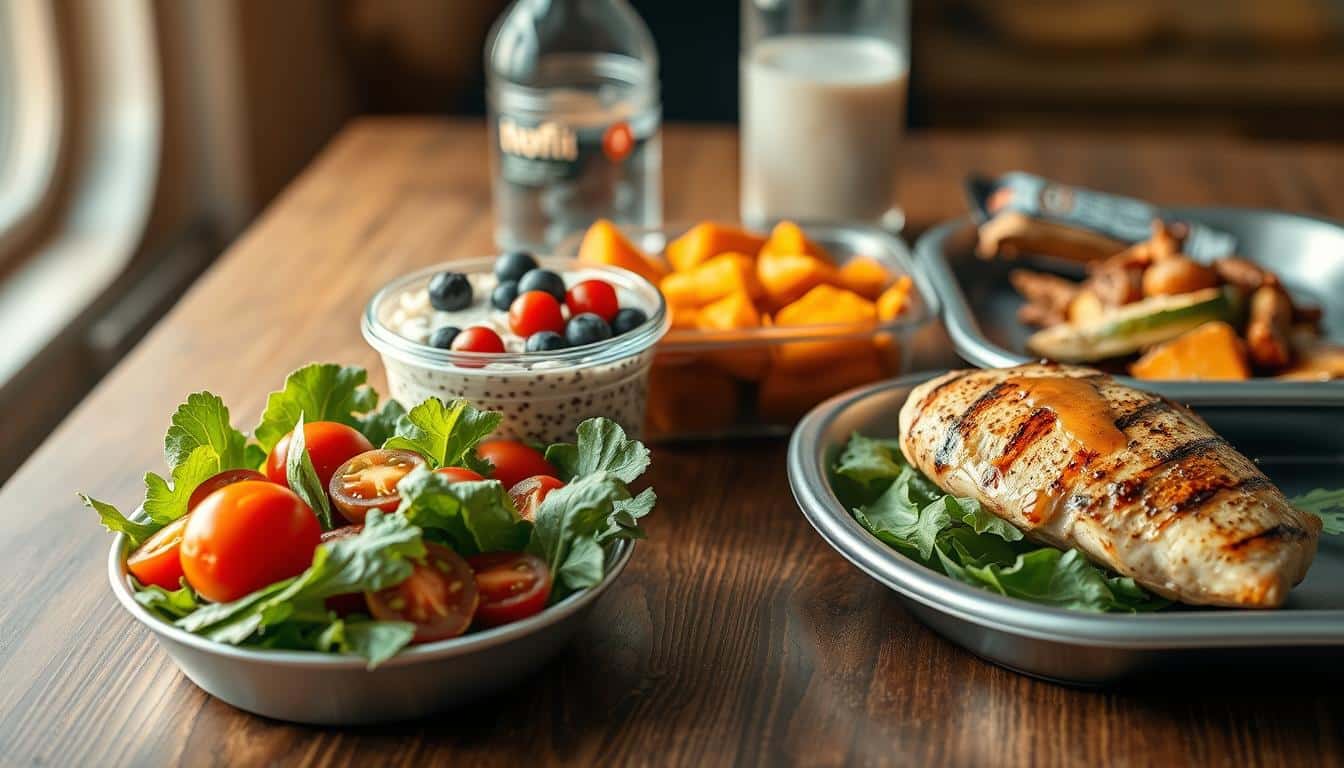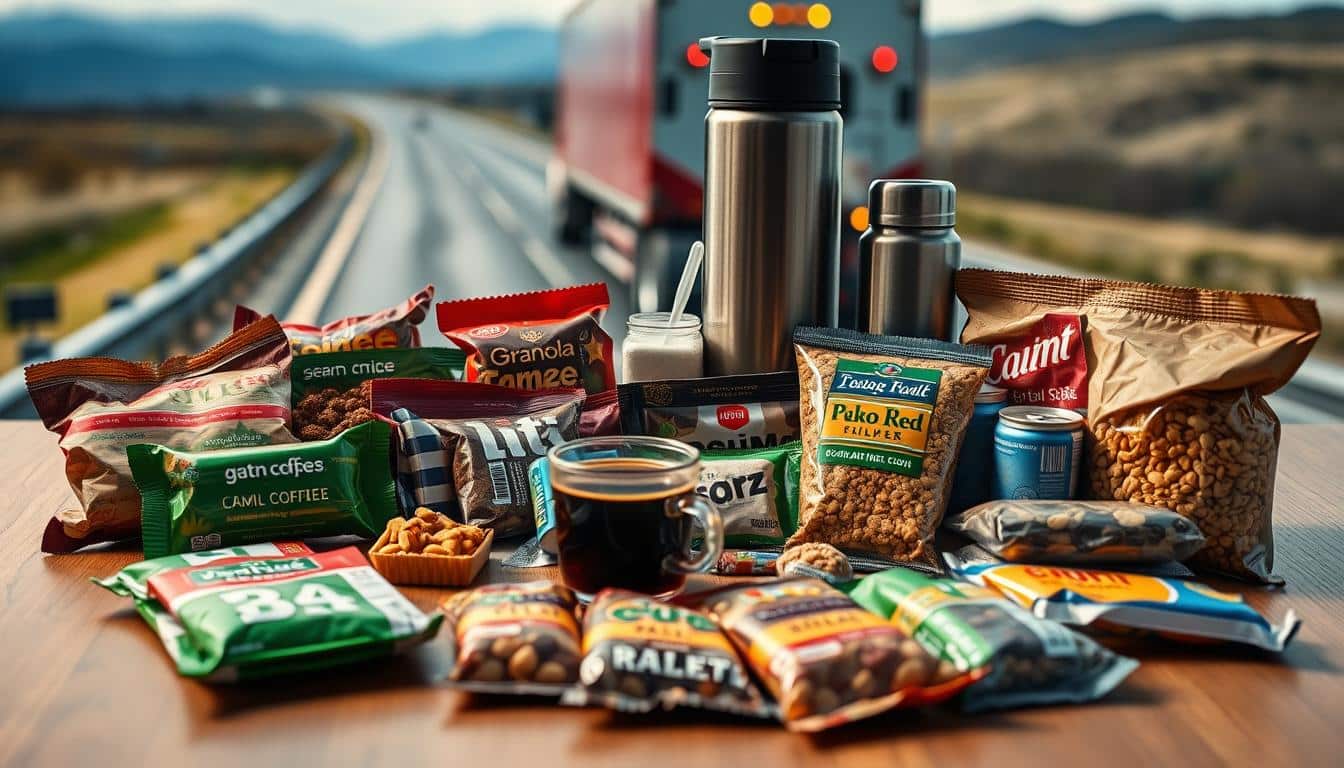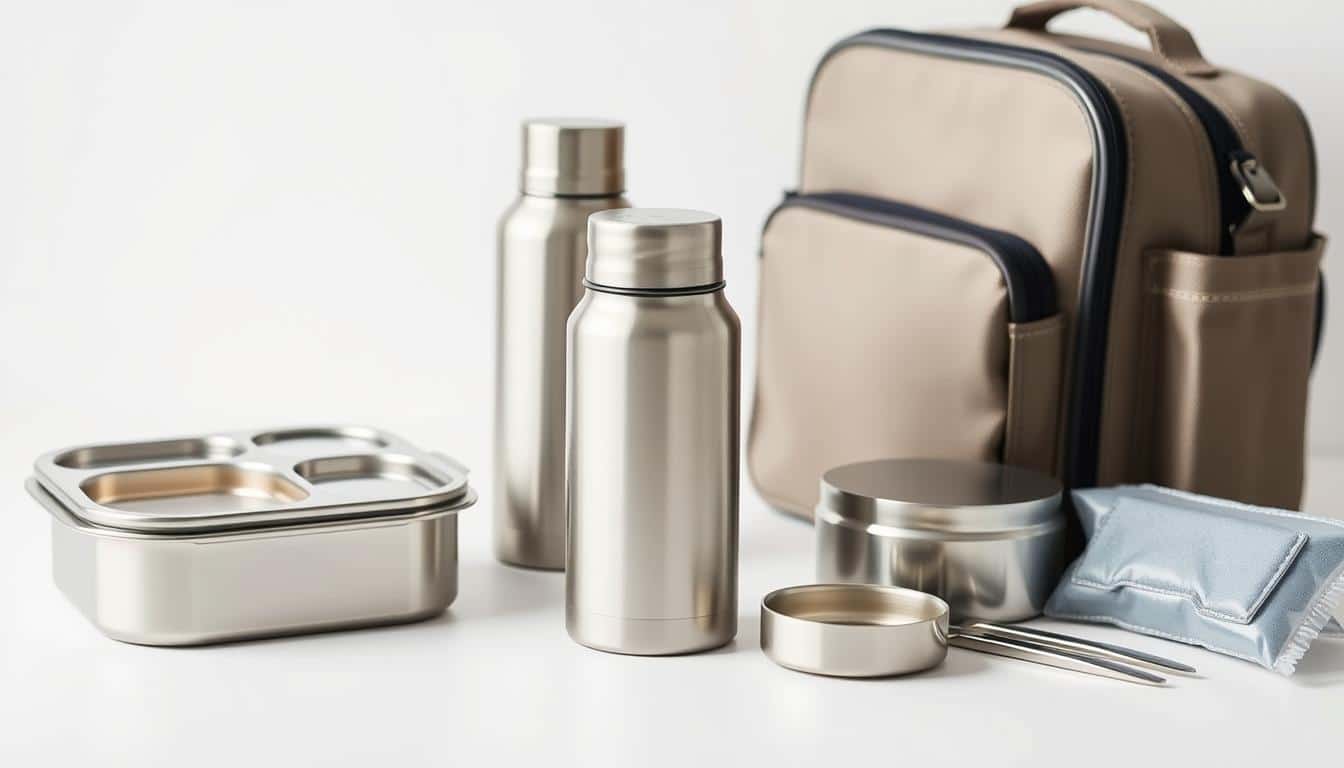Electric lunchbox cooking lets people enjoy hot meals anywhere, anytime. It’s perfect for anyone who’s always on the move. Commuters, teachers, and others can have a warm meal without needing a microwave or spending lots on takeout.
Many are searching for “Electric Lunchbox Recipes” on social media and Pinterest. There are hundreds of searches and lots of recipes to try. Brands like Travelisimo and Heatsbox Go are getting noticed for making meal prep easy.
Using an electric lunchbox means saving money and reducing food waste. It also means enjoying a wide range of hot meals like steamed veggies, rice dishes, and more wherever you are.
This guide will show you how electric lunchboxes work. It will help you pick the right one and share tips for tasty meals on the go. With this info, making a hot lunch easy and enjoyable is a breeze.
Why Electric Lunchbox Cooking Is Changing How Americans Eat
Electric lunchboxes are changing the game for office desks, job sites, and flights. Searches for electric lunchbox recipes spike on Pinterest. People are swapping cold sandwiches for warm, homemade-like meals.
Stories from real users support this trend. Chicago’s Ashley Sampson and flight attendant Serenity Hannah-Kaeo share how electric lunchboxes cut costs. They avoid expensive airport food. Many devices heat food in just 15–20 minutes,
Affordable models perform well, according to reviews. Even budget-friendly lunchboxes keep meals hot. They can cook simple dishes, proving electric lunchboxes are a smart choice.
- From cold, crushed lunches to hot, fresh meals
Heated electric lunchboxes make packed meals taste better. They reheat leftovers, steam veggies, and keep food moist. It’s like having dinner for lunch. - Cost savings compared to daily takeout and vending options
Using a lunchbox saves money compared to daily takeout. Workers and travelers notice the savings quickly. They enjoy warm meals over fast food purchases. - Reduced food waste and smarter meal prep for busy lifestyles
An electric lunchbox guides smarter meal prep. It encourages using leftovers and portion control. It leads to less waste and more time for users.
Electric lunchboxes offer freedom from office microwaves. They promote healthier eating and budget-friendly habits. Less reliance on disposable packaging makes them a practical choice for daily meals.
How Electric Lunchboxes Work: Features and Technology Overview
Electric lunchboxes heat up meals at work or during travel. They make cold food hot using compact heating systems. Knowing how they work and their features helps you choose the right one for your routine and safety needs.
They usually heat food from the bottom. This heats food evenly, especially if you stir liquidy dishes. Foods like chopped veggies and thin gravies heat up well, unlike thicker foods.
-
Heating elements and steaming: Some have a steam tray for moist rice and proteins. It’s like having a mini crockpot that gently cooks raw or partly cooked food.
-
Two-compartment designs: These models let you heat one dish and keep another cold. They’re great for variety without mixing flavors.
Heating elements, steaming capability, and bottom-up cooking
Heat usually comes from a metal or ceramic plate. It warms the food in a steel insert or in safe plastic. For more active cooking, add some water to create steam.
Stirring food during heating prevents cold spots. Sealed parts and steam control keep leftovers from getting soggy while bringing back texture.
Power options: mains, car adapter, and battery-powered models
How a lunchbox gets power impacts where you can use it. Plug-in types are for homes and cars. They often come with a car adapter.
Battery ones are good for places without plugs. Choose based on where you’ll use it, your charging habits, and heating time needs without a recharge.
-
Plug-in units: They provide strong, steady heat if you’re near a power source.
-
Battery models: These are portable and might even charge your phone. But, expect less heat over time and watch for battery life.
Materials and safety features: stainless steel inserts, insulated cases, and auto-shutoff
What the lunchbox is made of affects taste and how long it lasts. A stainless steel part inside is easy to clean and doesn’t smell like plastic. They often use high-quality steel for these parts.
Most have thick insulation and cases that keep heat in. Look for safety features like auto-shutoff and thermal fuses. They stop the lunchbox from overheating when it’s empty or closed tight.
-
Cleaning and longevity: You can remove the steel parts to wash them. This keeps the lunchbox from rusting over time.
-
Safe use tips: Keep air vents open, be careful with cords, and follow the guide for using the car adapter safely.
Top Benefits for Commuters, Construction Workers, and Flight Crews
Electric lunchboxes heat up food on the go. They are perfect for those who can’t use workplace microwaves or who have few food choices. Commuters and remote workers find them useful for a hot lunch.
On-the-go hot meals without microwave access
- These lunchboxes use plugs or batteries to warm food in 15–20 minutes. This means no waiting for microwaves.
- Flight attendants use these during long layovers. It helps with their unpredictable schedules.
- Tradespeople on job sites eat fresh with construction worker lunchboxes. These work where there are no microwaves.
Time and money savings for shift workers and frequent travelers
- Skipping daily takeout saves money. Using an electric lunchbox reduces food expenses over time.
- Commuters save time and money. They don’t need to stop for snacks or search for meals.
- Flight crews cut down on quick buys. They have ready meals in their lunchboxes.
Improved nutrition control for health-conscious professionals
- Home-packed meals allow for better food control. Workers can choose healthier meals.
- Construction workers get the calories they need from home-cooked food. This includes stews and veggies.
- Traveling professionals eat consistently. They avoid airline food, which is often unhealthy.
Users love these lunchboxes. A sprinkler fitter enjoys on-site hot meals. A flight attendant spends less and eats healthier. Reviews say car adapters and battery packs are great for commuters.
Best Meals and Recipes for Electric Lunchbox Cooking
Electric lunchbox recipes are great with moist, thin, or mixed dishes. This matches the device’s way of cooking with heat and steam from below. Remember to pack garnishes separately. This keeps their texture nice when you put them back on after heating.
For a tasty lunch, try steamed salmon. Put flaked fish over jasmine rice with quick-steamed broccoli on the side. The salmon cooks quickly and keeps its moisture. The rice picks up the steam’s flavor. Add lemon and scallions for a zesty flavor.
Mini crockpot meals are easy to make in single servings. You can make shredded chicken with barbecue sauce, or a slight thinner beef stew, or even coconut curry shrimp. These meals stay moist and warm all around.
- Pack stews, rice bowls, and soups by themselves for easy reheating.
- For layering: start with grains or heavier items at the bottom, then soft veggies, with fragile toppings last.
- To keep the texture right: if you can, stir halfway through. Or cut solid pieces smaller so everything heats up evenly.
Stick to simple meal ideas. A rice bowl, a protein that’s been steamed, and a small veggie side work well. Chili, stewed beans, and shredded pork are also great choices no matter the lunchbox brand.
For desserts like steamed sweets or custards, use shallow dishes. It helps them cook all the way through. Thin mixes for batters and puddings work better than thick ones. Follow Korie Haswell’s tip: steer clear of tall, dense items that won’t cook evenly.
- For a steamed salmon lunch: add the seasoned fish over rice, and a bit of water or broth. Cover, heat until it’s cooked fully.
- Mini crockpot lunch ideas: make a cup of pulled meat with sauce and a soft veggie for keeping it moist.
- For easy lunchbox meals: measure single servings ahead. Freeze or refrigerate them for quick packing later.
Try these ideas to make more exciting meals. Coconut rice with mango shrimp, Mongolian beef, and savory steamed egg puddings are great for electric lunchboxes. Just make sure to choose dishes that steam well for consistent cooking.
Meal Prep Strategies to Maximize Electric Lunchbox Efficiency
Turning evening meals into lunch is easy with a few smart routines. Plan meals that reheat well in your electric lunchbox. Small changes can make food taste great even after reheating.
Batch cooking for lunchbox saves both time and food. Cook big amounts of foods like chili, stews, or rice at once. Then, divide them into single servings and label for easy weekday choices.
Choose steel inserts or heat-proof containers that match your lunchbox. Space inside lets steam move, making food heat evenly. For best results, put moist foods at the bottom and dry ones on top.
- Use single-serve portions for consistent heating.
- Keep containers from being too full to close easily.
- Add fresh toppings like cilantro after heating.
Change slow cooker recipes to work in a lunchbox by making the sauce thinner. Also, chop meats into smaller pieces for even heating from below.
Brown meats before adding to recipes for more flavor. Pre-cooked food heats more consistently than raw food in a lunchbox.
Batch cooking for lunchbox is great with foods like stews and shredded chicken. They reheat well and stay tasty. Serve with grains or steamed veggies for a full meal.
For better reheating, let meals warm up a bit first. Stir halfway through heating to avoid cold spots. Always check the temperature before eating.
- Chill food quickly, then refrigerate to keep it safe and tasty.
- Reheat food on medium and stir after a few minutes.
- Use a fork to make sure the meal is hot all through, about 165°F for leftovers.
Choosing the right container is key. Pick ones designed for heating and that fit your lunchbox. Insulated bags keep food warm on the go. Keep eating utensils, labels, and extra seals handy for smooth meal prep.
Teachers and testers find using one recipe all week works well. It makes planning easier and helps improve heating times. Small changes at dinner mean better lunches the next day.
Choosing the Right Electric Lunchbox for Your Needs
When selecting an electric lunchbox, consider your daily activities. Commuters might like a plug-in type that warms food quickly. People working outdoors could need a lunchbox with a long battery life. And tech enthusiasts may want one they can control with an app.
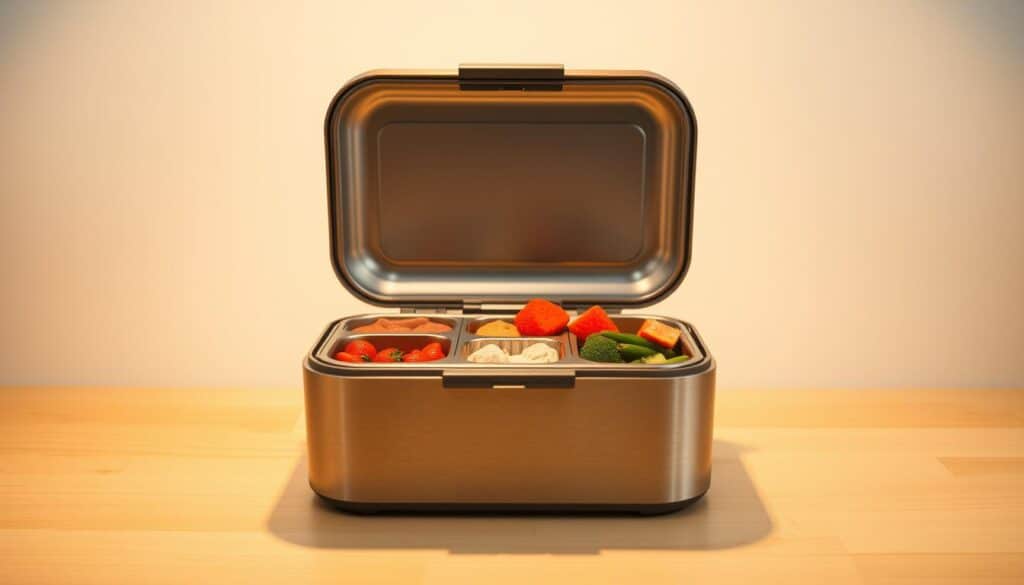
Budget-friendly choices usually include mains-only or models that plug into your car. They reheat food quickly and offer good value. If you spend a bit more, you can get a model with batteries, better keeping food warm, and tougher containers. The top-tier lunchboxes let you adjust the heat precisely with an app but may have shorter battery life due to those smart options.
Key specs to compare
- Temperature range: Check whether the unit cooks from raw or only reheats.
- Lunchbox battery life: Verify runtime in real use, not just ideal lab claims.
- Portability: Weight, carry case, and whether a 12V car adapter is included.
- Power choices: Look at plug-in vs battery lunchbox designs to match daily routines.
Accessories and extras
Extras like insulated bags help keep your food warm longer. Dividers, simple eating tools, and leak-proof tops make life easier. A lunchbox you can control with your phone is cool for heating food while on the move. Just make sure the smart features are worth it.
Buying checklist
- Confirm power options: AC mains, 12V car adapter, internal battery.
- Verify safe materials: food-grade stainless steel and BPA-free seals.
- Test usable temperature range for your recipes.
- Compare advertised lunchbox battery life to real reviews.
- Decide if extras like an insulated bag or smartphone control matter to you.
Experts and chefs often say a well-priced plug-in lunchbox can be better than pricier ones. Find what features you really need. Then, picking your ideal electric lunchbox will be easier.
Practical Tips and Tricks from Users and Chefs
Chefs and everyday users offer tips on electric lunchboxes, helping transform good meals into great ones. Minor adjustments can significantly impact, especially with lunchboxes heating from the bottom. These tips come from community boards, HotLogic guides, and direct reviews.
Begin with considering texture. Choose thin slices, small dices, and soft grains for even cooking. Stirring halfway through cooking prevents hot spots and ensures steam distribution. If you’re adapting oven recipes, press down layers and cut back on liquid.
-
Chef Ron Stewart from Portland suggests using small portions for raw dishes. He also advises on separating raw and cooked foods in models with two compartments.
-
User Korie Haswell and others note that stirring every 10-15 minutes is key due to bottom heating. This ensures consistent texture.
-
A useful trick is to use broths or thin purees instead of thick sauces. This helps heat move faster when cooking raw food.
Choosing between cooking and reheating is important. Cooking raw items works best for quick proteins, rice, and vegetables. Reheating saves time and effort. Precooked grain bowls with a steamed vegetable on top can taste like they’re from a restaurant.
-
For cooking raw: make items small, add a bit of liquid, and check the temperature before eating.
-
For reheating: heat food safely at home, then cool it. Store in stainless steel for reheating at work or while traveling.
-
For desserts: try single-serve pudding or fruit compote. They’re great in the gentle heat of a HotLogic.
Electric lunchboxes are versatile. Teachers and office workers use them for fresh, hot meals. Construction and field teams appreciate models that work in vehicles. Flight crews pick them for ease during layovers, choosing based on power source.
Keep cleaning and safety simple. Opt for stainless steel inserts, clean seals after use, and let the device cool before putting it away. These practices keep lunchboxes in good shape for long-term use.
Safety, Cleaning, and Maintenance Best Practices
Always prioritize safety and care to get the best out of your electric lunchbox. Place it correctly, clean regularly, and perform simple maintenance. This lowers risk and increases its lifespan. Make sure to read the manual for specific advice and follow these basic tips.
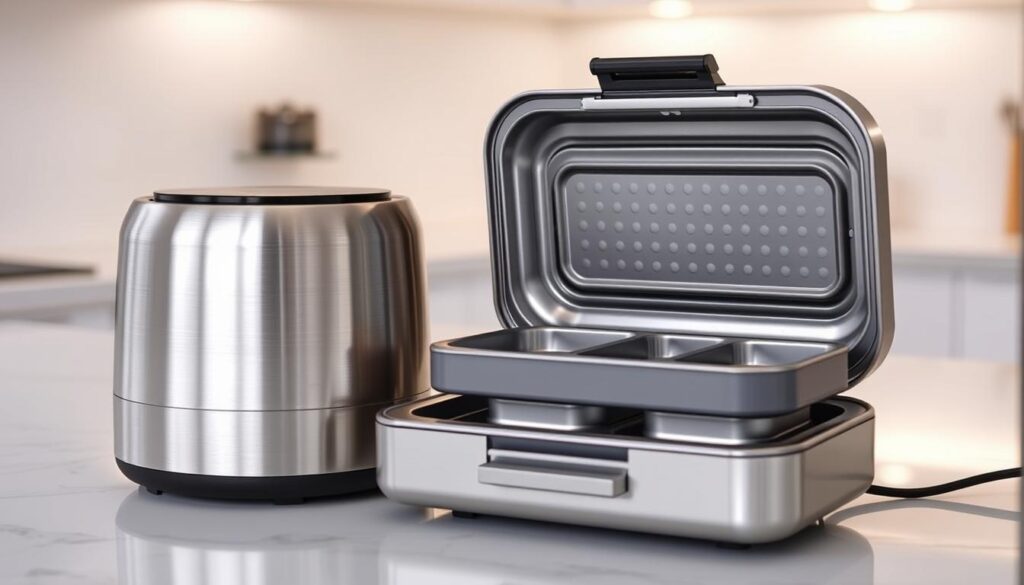
- Set the lunchbox on a stable, heat-proof surface. Ensure there’s 3–4 inches around it for air flow. This prevents overheating and promotes safety.
- Keep the power cord clear of places people walk and away from heat. Secure the plug and keep the cord straight to avoid damage and accidents.
- Do not put the base or area for batteries under water. Always unplug it before cleaning. Wait until it cools off to touch it.
Cleaning stainless steel inserts and seals
- Take out stainless steel parts and wash off food right away. They are often safe for dishwashers. Yet, washing by hand helps them last longer and avoids water spots.
- Remove seals from the lid for a careful wash in soapy water. Make sure they’re totally dry before putting them back to stop smells or mold.
- Clean bags that keep heat in and let them dry in open air. If stains stick around, gently use a mild soap and a soft brush.
Lunchbox maintenance and longevity tips
- Clean the outside and buttons with a slightly wet cloth. Stay away from sprays that might get into the electrical parts.
- Wait for the lunchbox to cool down before you put it away. Leave lids a bit open or take off seals to avoid any bad smells.
- Stick to the suggested temperatures and don’t run it when it’s empty. These actions help prevent damage and make your lunchbox last longer.
Paying attention to these details helps keep your lunchbox working better and longer. Take apart parts that touch food after using and check the cords every month. These simple steps will ensure your lunchbox remains in top shape for many years.
Cost, Value, and Environmental Impact of Electric Lunchboxes
An electric lunchbox can change daily habits at work, on job sites, or during travel. The upfront cost is weighed against long-term savings and the impact on the environment. We’ll look at the costs, benefits, and how making smart choices can increase lunchbox value and cut down on waste.
Prices of electric lunchboxes range from under $30 to over $100. Budget-friendly options like Travelisimo usually offer basic heating. Premium models like Heatsbox come with battery power and app controls but cost more. Ashley Sampson and Serenity Hannah-Kaeo have shown that using electric lunchboxes saves money otherwise spent on daily takeout and airport meals.
To see when you’ll start saving money, compare your daily food spend to the savings from packing lunches. Many find that bringing hot meals can pay off the lunchbox cost in just a few months.
Environmental benefits and waste reduction
Choosing an eco-friendly lunchbox means less use of disposable items. With stainless steel inserts and reusable boxes, you cut down on wrappers and plastic forks. This move lessens the waste from coffee shops and quick food places.
It also helps in managing food portions, reducing leftovers and waste. Using a lunchbox that can be fixed, you’re keeping items from filling up landfills. This action helps our planet and keeps costs down over time.
Choosing durable, repairable models
- Opt for stainless steel inserts as they last longer and are easier to clean.
- Check if seals, cords, and batteries are replaceable to make the lunchbox last longer.
- Consider reviews about warranty service and parts availability before buying.
By choosing a lunchbox that’s built to last, you’re putting off the need to buy a new one. This approach saves money and is better for the planet.
Practical tips to maximize value
- Pick a lunchbox with features you really need. Don’t overpay for fancy tech if it’s not useful to you.
- Keep an eye on how much you spend on takeout each week. Compare it to what you could save with a lunchbox.
- Go for a lunchbox that’s eco-friendly and easy to fix or recycle with its modular design.
Making smart choices in purchasing and using an electric lunchbox makes a difference. These decisions lead to saving money and reducing waste through consistent use and careful selection.
Popular Electric Lunchbox Models and What Reviewers Say
On forums and product boards, readers share their thoughts on electric lunchboxes. They like budget models for their steady heat and simple design. The mid-range, cordless options are great for taking on the go. And the high-end models? They’re known for their cool tech features and precise temperature settings.
The Travelisimo lunchbox is a hit for those looking for a deal. It’s praised for heating up food well, whether at home or in a car. Plus, it’s built to last, even with everyday use.
Mid-range models with batteries and extra features
A review of the GameXop unit mentions its handy battery and insulated case. People love taking it anywhere and using it to charge their phones too. For chefs and commuters, its battery means more freedom, even on busy days.
Premium app-connected units and trade-offs like battery life
Opinions on the Heatsbox Go are mixed. Its app and temperature options wow the tech lovers. But, some are turned off by its short battery life and higher cost. This may not work for those who need to warm their meals several times a day.
- Heat in 15–20 minutes is a big plus for daily use.
- Being able to boil water in 30–45 minutes adds value for flexibility.
- The most affordable models are often named the best for their value.
What you pick depends on your lifestyle. A plug-in model is good for office use. For those on the move or working remotely, spending more on a battery-powered one makes sense. And if you like advanced settings and tech, premium models are best. Just remember, they might cost more and need charging more often.
Conclusion
It’s clear that electric lunchboxes are great for anyone on the go. They work well for commuters, office workers, and many others. They heat up food quickly, making meals tasty and healthy.
Both plug-in and battery-powered types are good choices. They’ve been tested and praised for being reliable. You’ll spend less on food, eat better, and cut down on waste.
When choosing one, think about where you’ll use it. Get a plug-in model for the office. Choose a battery one if you need to move around. Look for ones with stainless steel inside and features like auto-shutoff.
Begin with easy recipes that heat well. Try making stews or rice dishes. Make sure to stir them and keep them from getting too thick. Cleaning well will also make your lunchbox last longer.
This way, you’ll save money and help the planet. Using an electric lunchbox is smart and sustainable.
FAQ
What is an electric lunchbox and how does it change my daily meals?
How do electric lunchboxes actually cook food?
What power options are available?
Which meals work best in an electric lunchbox?
Can I cook raw meat or fish in these devices?
How long does it take to heat a typical lunch?
Are electric lunchboxes safe to use at work or in a car?
How do I clean and maintain an electric lunchbox?
What should I look for when buying—budget vs. premium?
How much can I realistically save by using an electric lunchbox?
Do electric lunchboxes reduce food waste and environmental impact?
Can I meal-prep for electric lunchbox use?
What recipes should I avoid or adapt carefully?
Are there accessories I should consider?
How do users and chefs recommend maximizing success?
Which brands and models are commonly recommended?
What are the common safety and material concerns?
How do I adapt recipes from Pinterest and online boards?
Is an electric lunchbox worth it for commuters, teachers, and shift workers?
Content created with the help of Artificial Intelligence.

